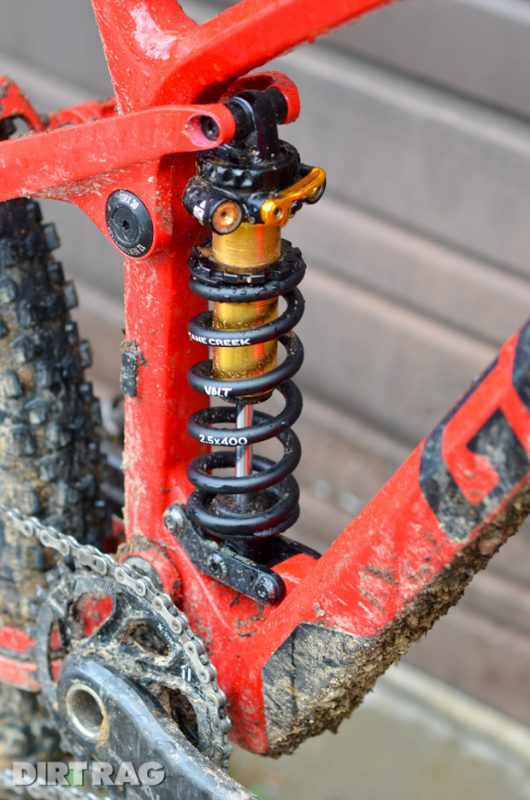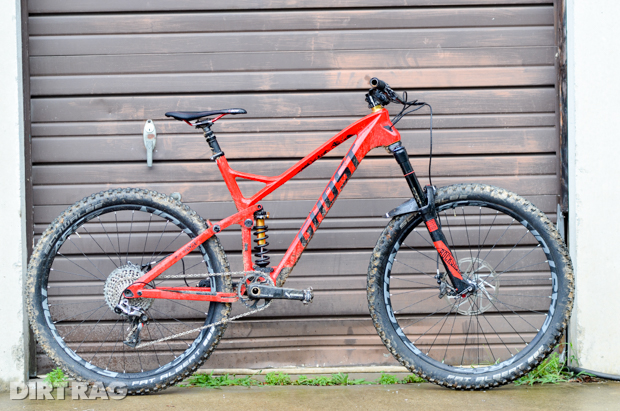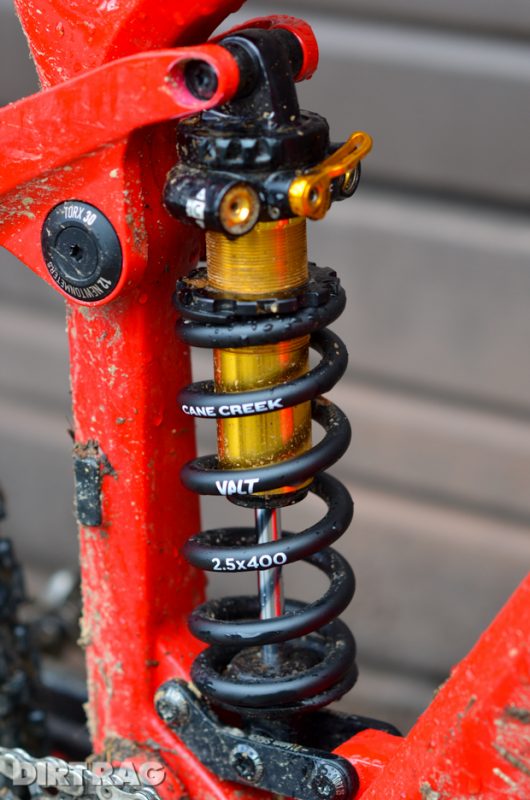Cane Creek releases DB Coil Inline, a trail bike coil shock
Originally posted on August 19, 2016 at 10:00 amThe DBCoil [IL] is a high performance, non-piggyback, coil shock aimed squarely at the trail bike market.

Cane Creek describes its features thusly:
• Twin-Tube Design.
-Setting the DBcoil[IL] apart, oil circulates continuously through externally adjustable shock
valves. On the trail, this routing of oil translates into less fade, more control, and greater consistency making it the
most highly capable inline coil shock on the market.
• Four-Way Independent Adjustment.
-Like other Double Barrel shocks, the DBcoil[IL] offers an unparalleled range of
adjustability through external adjusters that independently control each phase of damping without crossover
effects.
• Patented Climb Switch (CS) Technology.
-When engaged, both low-speed compression and low-speed rebound damping settings are altered simultaneously to achieve improved pedal efficiency and less chassis motion while maximizing traction.
• Base Tunes and the DIALED App.
-Cane Creek’s online Tune Finder provides riders with frame-specific recommended settings based on bike geometry and rider input. From there, riders are encouraged to fine tune their suspension for personal styles and preferences using Cane Creek’s free mobile Tuning App DIALED.
Background
Air Sprung rear shocks won the trail bike market years ago. But coil shocks on trail bikes never died out completely. Cane Creek added a CS (Climb Switch) option to its piggyback DB Coil shock awhiles back, and Push recently came out with the hyper-expensive ($1,200) ElevenSix coil shock, also with a platform switch. But how about trail bikes that don’t have room for a piggyback? Cane Creek was thinking the same thing. Actually, it was only a few employees who were thinking the same thing, and spent some time after hours machining parts to cobble together an inline coil shock using the body of a DB Inline air shock.

Obviously that rough first prototype worked well enough to refine the design, and enough people at the employee-owned Cane Creek were convinced to take this on to production. And that brings us to the sore spot that is the DB Inline. When these shocks are working, they are an amazing product. But, they haven’t always worked as intended The Inline is a very complex product, made up of a lot of different parts, from a lot of different vendors. It’s been a rough ride for both the consumers and Cane Creek. But unlike a lot of companies that will close ranks and not discuss problems like this, Cane Creek was entirely open, and explained the changes made to eliminate these problems.
A quality control engineer has been added to the staff, processes have been improved, vendors have been changed and warranties have been handled in a prompt and courteous manner. I’m sure this has been a painful period for Cane Creek, but keeping riders as happy as possible while replacing under-performing product seems to have gone a long way in keeping Cane Creek’s reputation intact. I mention all this because this new shock is uses much the same damper design as the problematic air Inline. But this shock starts out with all the improved processes and parts, so the Coil Inline should be a more robust damper right off the bat.
Why Coil?
Coil springs are more supple in the initial travel as there is much less seal friction to overcome compared to an air shock, Coil springs need no negative spring to help counter the friction from those high-quality seals needed to keep the air in the air can. Coil spring shocks run cooler than air shocks, mostly because there is no layer of air acting to hold the heat in the damper. Some riders really like the linear spring rate a coil shock provides.
Why not Coil?
Coil springs are heavier. Riders of different weights will need to swap springs for proper spring rate. Most modern suspensions are designed around the spring curve of an air shock, and while these continue to get more and more linear, there isn’t a ramp up at the end of coil shock. Coil spring shocks are less tuneable compared to modern air shocks which often offer both preload and volume adjustments.
Riding

I took this Ghost FR AMR (160mm f/r travel) out for a wet and rowdy ride on some wet and rowdy trails that were not in the Pisgah forest or the Dupont forest. Instead we headed to the trails of the Green River Game Lands which are steep and natural, and require a lot of climbing to access the fun bits. They also hold up to rain very well. I expected to use the Climb Switch a lot, but with all the technical climbing, and the firm platform spec’ed by the Germans at Ghost, I left the shock open almost the whole time and it felt fine. This might have more to do with the suspension kinematics of this bike, and my own riding style than the shock being very efficient. It certainly didn’t feel at all bad.
Going down on some enduro-y trails, I was probably more worried about keeping things upright than being super tuned into the rear shock was doing, but as I got more comfortable on the bike I started to really enjoy the seamless feel of the Coil Inline. Controlled traction is perhaps the best I can come up with for the feel of the rear shock. It may have made the Pike up front feel a little harsh, a real challenge for most rear shocks.

I was hoping for some places to test the bottom out resistance, but is was mostly all medium size hits along with lot of roots. Cane Creek admitted this shock is probably going to bottom out more often than an air shock, but an 8 mm bumper should prevent metal to metal contact. The rear suspension felt very controlled; no mid-stroke wallow, no uncontrolled rebound. Mostly, after riding this shock, I came away wanting more time on it. Which is being arranged.
These will be ready in both metric and standard sizes for $550 (without the spring)
Standard
190 x 50mm (7.48”x 1.96”)
200 x 50mm (7.87” x 1.96”)
200 x 57mm (7.87” x 2.24”)
216 x 63mm (8.5” x 2.48”)
Metric
190x40mm (7.48” x 1.56”)
190x45mm (7.48” x 1.77”)
210x50mm (8.2” x 1.96”)
210x55mm (8.2” x 2.16”)
Valt Spring
 Ti spring are often used on high end shocks to reduce weight, but there is no way around how expensive they are. Titanium is hard work with, and expensive, and is the most consistent material to make springs from. Cane Creek wanted something nicer than a standard steel spring but without the expense of Ti. The Valt is the result. Using a high-strength steel, the Valt uses less material in (almost 200 grams less) than a standard steel spring. That high quality steel also yields very consistent spring rates, all at half the price of a Ti spring or $170).
Ti spring are often used on high end shocks to reduce weight, but there is no way around how expensive they are. Titanium is hard work with, and expensive, and is the most consistent material to make springs from. Cane Creek wanted something nicer than a standard steel spring but without the expense of Ti. The Valt is the result. Using a high-strength steel, the Valt uses less material in (almost 200 grams less) than a standard steel spring. That high quality steel also yields very consistent spring rates, all at half the price of a Ti spring or $170).